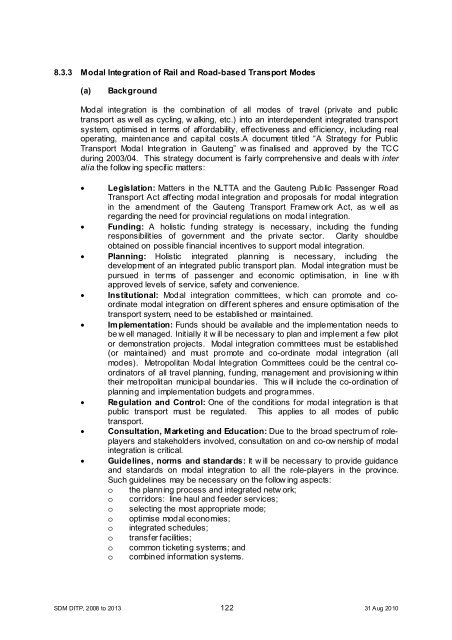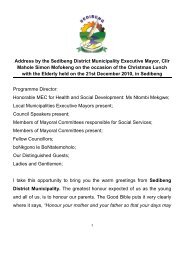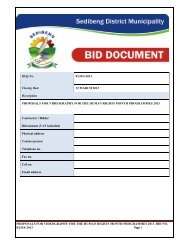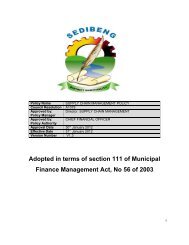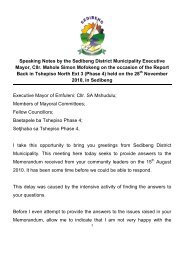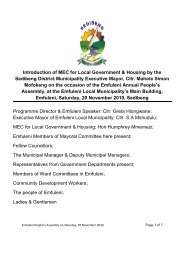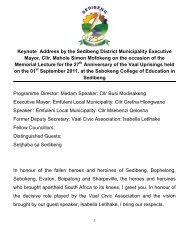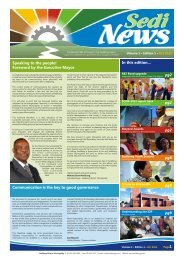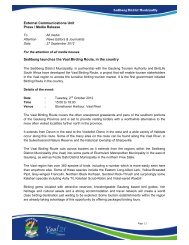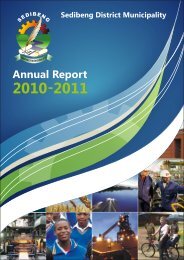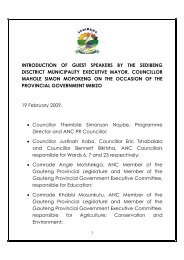Chapter 11 - Sedibeng District Municipality
Chapter 11 - Sedibeng District Municipality
Chapter 11 - Sedibeng District Municipality
Create successful ePaper yourself
Turn your PDF publications into a flip-book with our unique Google optimized e-Paper software.
8.3.3 Modal Integration of Rail and Road-based Transport Modes<br />
(a)<br />
Background<br />
Modal integration is the combination of all modes of travel (private and public<br />
transport as well as cycling, w alking, etc.) into an interdependent integrated transport<br />
system, optimised in terms of affordability, effectiveness and efficiency, including real<br />
operating, maintenance and capital costs.A document titled “A Strategy for Public<br />
Transport Modal Integration in Gauteng” w as finalised and approved by the TCC<br />
during 2003/04. This strategy document is fairly comprehensive and deals w ith inter<br />
alia the follow ing specific matters:<br />
• Legislation: Matters in the NLTTA and the Gauteng Public Passenger Road<br />
Transport Act affecting modal integration and proposals for modal integration<br />
in the amendment of the Gauteng Transport Framew ork Act, as w ell as<br />
regarding the need for provincial regulations on modal integration.<br />
• Funding: A holistic funding strategy is necessary, including the funding<br />
responsibilities of government and the private sector. Clarity shouldbe<br />
obtained on possible financial incentives to support modal integration.<br />
• Planning: Holistic integrated planning is necessary, including the<br />
development of an integrated public transport plan. Modal integration must be<br />
pursued in terms of passenger and economic optimisation, in line w ith<br />
approved levels of service, safety and convenience.<br />
• Institutional: Modal integration committees, w hich can promote and coordinate<br />
modal integration on different spheres and ensure optimisation of the<br />
transport system, need to be established or maintained.<br />
• Implementation: Funds should be available and the implementation needs to<br />
be w ell managed. Initially it w ill be necessary to plan and implement a few pilot<br />
or demonstration projects. Modal integration committees must be established<br />
(or maintained) and must promote and co-ordinate modal integration (all<br />
modes). Metropolitan Modal Integration Committees could be the central coordinators<br />
of all travel planning, funding, management and provisioning w ithin<br />
their metropolitan municipal boundaries. This w ill include the co-ordination of<br />
planning and implementation budgets and programmes.<br />
• Regulation and Control: One of the conditions for modal integration is that<br />
public transport must be regulated. This applies to all modes of public<br />
transport.<br />
• Consultation, Marketing and Education: Due to the broad spectrum of roleplayers<br />
and stakeholders involved, consultation on and co-ow nership of modal<br />
integration is critical.<br />
• Guidelines, norms and standards: It w ill be necessary to provide guidance<br />
and standards on modal integration to all the role-players in the province.<br />
Such guidelines may be necessary on the follow ing aspects:<br />
o the planning process and integrated netw ork;<br />
o corridors: line haul and feeder services;<br />
o selecting the most appropriate mode;<br />
o optimise modal economies;<br />
o integrated schedules;<br />
o transfer facilities;<br />
o common ticketing systems; and<br />
o combined information systems.<br />
SDM DITP, 2008 to 2013 122 31 Aug 2010


